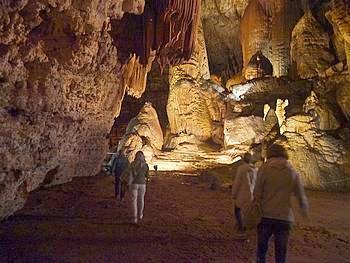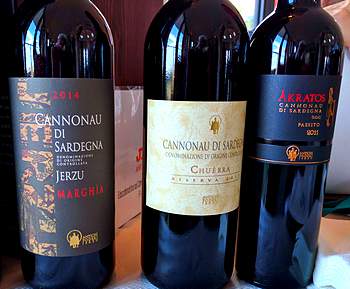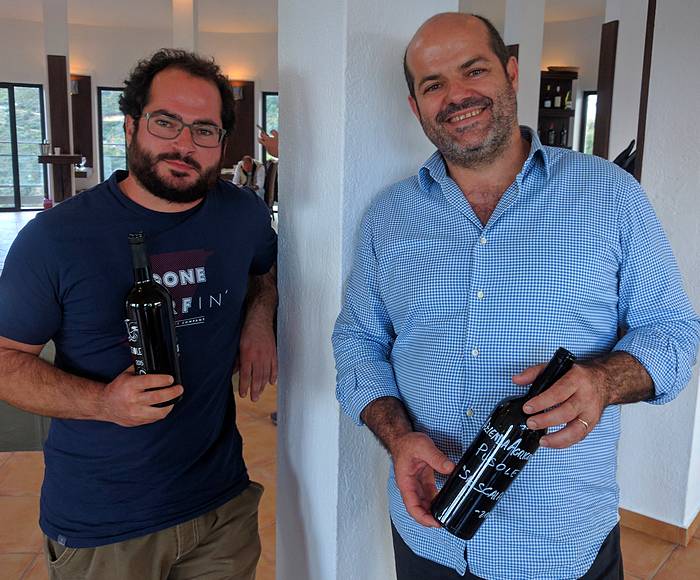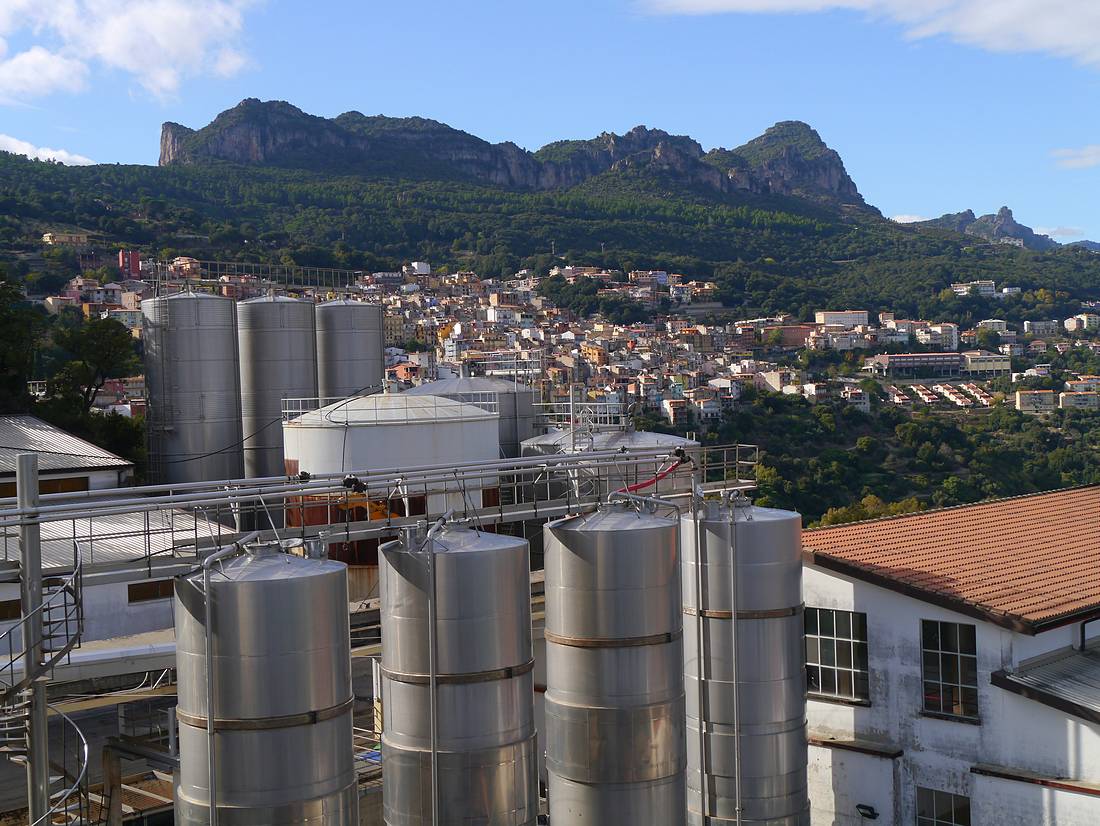Famed for its local strain of Cannonau, the vineyards of Jerzu grow in a massive natural amphitheater scooped out of the side of a limestone range. The basin ascends from sea level to 750 meters, and the soils are all a mix of soft limestone and crumbly schist. The photo above shows the ridge and the hillside village of Jerzu. The industrial site in the foreground is the Antichi Poderi Jerzu cooperative (www.jerzuantichipoderi.it/en/), which produces 1.8 million bottles a year.
 The predominance of limestone subsoil at Jerzu means that the vines have to live with scarce water that drains away underground. This drainage carves out great cavern systems for spectacular spelunking. On the outskirts of nearby Ulassai, the Grotta di Su Marmuri (www.grottasumarmuri.it) is open April through October for €10 guided tours. The journey takes about 90 minutes, including the time to climb a steep 100 meters up the mountain to the mouth of the cave. The descent of about 50 meters into the main chambers is much easier. Formed by water erosion during the Jurassic period, the cave system consists of several high-vaulted rooms with marvelously abstract stalactite and stalagmite formations.
The predominance of limestone subsoil at Jerzu means that the vines have to live with scarce water that drains away underground. This drainage carves out great cavern systems for spectacular spelunking. On the outskirts of nearby Ulassai, the Grotta di Su Marmuri (www.grottasumarmuri.it) is open April through October for €10 guided tours. The journey takes about 90 minutes, including the time to climb a steep 100 meters up the mountain to the mouth of the cave. The descent of about 50 meters into the main chambers is much easier. Formed by water erosion during the Jurassic period, the cave system consists of several high-vaulted rooms with marvelously abstract stalactite and stalagmite formations.
Antichi Poderi Jerzu
 The limestone basin has been known for a thousand years or more as a good place to grow grapes. Records from A.D. 1103 show the people of Jerzu paying tribute to the papal legate in wine rather than gold. Eighteen owners of the oldest vineyards launched the Vitivinicola Antichi Poderi Jerzu wine-grower’s cooperative in 1950. (“Antichi poderi” translates as “ancient estates” or “ancient parcels.”) Now boasting 430 members, this powerhouse cooperative also carries out extensive historical and technical research on Jerzu winemaking.
The limestone basin has been known for a thousand years or more as a good place to grow grapes. Records from A.D. 1103 show the people of Jerzu paying tribute to the papal legate in wine rather than gold. Eighteen owners of the oldest vineyards launched the Vitivinicola Antichi Poderi Jerzu wine-grower’s cooperative in 1950. (“Antichi poderi” translates as “ancient estates” or “ancient parcels.”) Now boasting 430 members, this powerhouse cooperative also carries out extensive historical and technical research on Jerzu winemaking.
The cooperative makes Cannonau wines in several styles and price points. Its basic young Cannonau di Sardegna, called Marghia, sells widely in the U.S. for less than $10. It is a bright young wine with raspberry notes and very soft tannins—easy-drinking red. The base riserva, called Chuerra, is made in much the same manner, but receives six months in large oak barrels and a year in small barrels before bottling. The combination of Slovenian and French oak imparts more structure to the tannins as well as pronounced cedar and eucalyptus herbal notes.
 The Josto Miglior riserva, named for a famous Jerzu doctor, is a more bracing version of Cannonau di Sardegna Riserva. I had the chance to taste a 2013, which was still very closed. The wine was elegant, but the tannins were so pronounced that they were like steel bones sticking out of a tuxedo. Then I tried a 2010, which was smooth and supple. The tannins and fruit were in perfect balance. Clearly, this wine rewards the patient buyer. It retails in the U.S. just under $20.
The Josto Miglior riserva, named for a famous Jerzu doctor, is a more bracing version of Cannonau di Sardegna Riserva. I had the chance to taste a 2013, which was still very closed. The wine was elegant, but the tannins were so pronounced that they were like steel bones sticking out of a tuxedo. Then I tried a 2010, which was smooth and supple. The tannins and fruit were in perfect balance. Clearly, this wine rewards the patient buyer. It retails in the U.S. just under $20.
Lorenzo Pusole
 Roberto and Lorenzo Pusole operate their family estate in Baunei, well north of Jerzu in a different range of hills. Located near Tortoli, their vineyards are planted in alluvial soils of mixed sand and stones. But the vines are very old. (The youngest were planted in 2004.) The slopes range 30 to 150 meters, and the brothers grow the white Vermentino grape on the lower reaches.
Roberto and Lorenzo Pusole operate their family estate in Baunei, well north of Jerzu in a different range of hills. Located near Tortoli, their vineyards are planted in alluvial soils of mixed sand and stones. But the vines are very old. (The youngest were planted in 2004.) The slopes range 30 to 150 meters, and the brothers grow the white Vermentino grape on the lower reaches.
I’ve rarely met wine growers who have gone so all-in for organic production. “We live in the vineyards,” explained Roberto. “A healthy environment is essential to our well-being.” In addition to grapes, the brothers raise semi-feral Razza Sarda pigs and grow heritage varieties of grain and olives.
The Pusole brothers make two versions of Cannonau di Sardegna. Both are fermented in stainless steel without temperature control using wild yeasts. Both wines remain on the skins for about 12 days, or until the initial fermentation subsides. In spring, spontaneous malolactic fermentation softens the wines.
The version bearing the family name, Pusole, is aged 10 months in stainless steel and three months in bottle. It is a lusty Cannonau with pronounced dark berry fruit, hints of leather and anise, and a nice herbal finish.
Spectacular Sa Scala
The version labeled Sa Scala is not registered as a riserva, but it does spend 16 months in small French oak barrels and a year in bottle before release. Made only in limited quantities (2,200 bottles last year), it’s expensive for Cannonau di Sardegna DOC, retailing around €50. (It’s not yet available in the U.S.) The complexity is remarkable enough to justify the price. With a comparatively low 13.5 percent alcohol and little residual sugar, it nonetheless boasts ripe and supple tannins. The fruit is elegant instead of jammy. The nose is so redolent of classic Mediterranean scrub, that you can almost hear the bees buzz as they gather their nectar.

